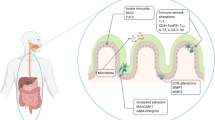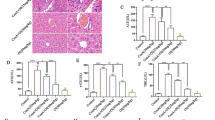Abstract
During clonorchiasis, immune responses of hosts are responsible for the removal of the worms and also are involved in the progress of the pathological damage caused by Clonorchis sinensis. Interleukin-33 (IL-33), a recently described cytokine signaling through the ST2 receptor, has emerged as a potent inducer to bile duct proliferation and fibrosis; however, little is known of this signaling in the pathogen-caused periductal inflammation and fibrosis. In the present study, using immunohistochemistry, real-time PCR, enzyme-linked immunosorbent assay (ELISA), and flow cytometry, we studied the expression of IL-33/ST2 during C. sinensis infection, as well as their potential roles in C. sinensis-induced host immune responses. The results showed that a higher level of IL-33 was detected in the sera of patients of clonorchiasis (n = 45), compared with in those of healthy donors (n = 16). Similarly, in FVB mice experimentally infected with C. sinensis, a higher level of IL-33 was detected at latent stage both in the serum and in the liver, as well as the up-regulated expression of ST2 receptor on the inflammatory cells, especially on CD4+ T cells in the liver of infected mice. Our results, for the first time, indicated that the increased IL-33/ST2 may be involved in the regulation of immunopathology induced by C. sinensis.




Similar content being viewed by others
References
Baumann C, Bonilla WV, Frohlich A, Helmstetter C, Peine M, Hegazy AN, Pinschewer DD, Lohning M (2015) T-bet- and STAT4-dependent IL-33 receptor expression directly promotes antiviral Th1 cell responses. Proc Natl Acad Sci U S A 112:4056–4061
Bian M, Xu Q, Xu Y, Li S, Wang X, Sheng J, Wu Z, Huang Y, and Yu X (2016) Investigation on oxidative stress of nitric oxide synthase interacting protein from Clonorchis sinensis. Parasitol Res 115:77–83
Brindley PJ, da Costa JM, Sripa B (2015) Why does infection with some helminths cause cancer? Trends Cancer 1:174–182
Cayrol C, Girard JP (2015) IL-33: an alarmin cytokine with crucial roles in innate immunity, inflammation and allergy. Curr Opin Immunol 31:31–37
Chen J, Duan L, Xiong A, Zhang H, Zheng F, Tan Z, Gong F, Fang M (2012) Blockade of IL-33 ameliorates Con A-induced hepatic injury by reducing NKT cell activation and IFN-gamma production in mice. J Mol Med (Berl) 90:1505–1515
Gajardo Carrasco T, Morales RA, Perez F, Terraza C, Yanez L, Campos-Mora M, Pino-Lagos K (2015) Alarmin’ immunologists: IL-33 as a putative target for modulating T cell-dependent responses. Front Immunol 6:232
Gao Q, Li Y, Li M (2015) The potential role of IL-33/ST2 signaling in fibrotic diseases. J Leukoc Biol 98:15–22
Harada K, Isse K, Sato Y, Ozaki S, Nakanuma Y (2006) Endotoxin tolerance in human intrahepatic biliary epithelial cells is induced by upregulation of IRAK-M. Liver Int 26:935–942
Kaewpitoon SJ, Rujirakul R, Kaewpitoon N (2012) Prevalence of Opisthorchis viverrini infection in Nakhon Ratchasima province, Northeast Thailand. Asian Pac J Cancer Prev 13:5245–5249
Kim EM, Bae YM, Choi MH, Hong ST (2012) Cyst formation, increased anti-inflammatory cytokines and expression of chemokines support for Clonorchis sinensis infection in FVB mice. Parasitol Int 61:124–129
Li M, Li Y, Liu X, Gao X, Wang Y (2012) IL-33 blockade suppresses the development of experimental autoimmune encephalomyelitis in C57BL/6 mice. J Neuroimmunol 247:25–31
Li J, Razumilava N, Gores GJ, Walters S, Mizuochi T, Mourya R, Bessho K, Wang YH, Glaser SS, Shivakumar P, Bezerra JA (2014) Biliary repair and carcinogenesis are mediated by IL-33-dependent cholangiocyte proliferation. J Clin Invest 124:3241–3251
Liang Y, Jie Z, Hou L, Aguilar-Valenzuela R, Vu D, Soong L, Sun J (2013) IL-33 induces nuocytes and modulates liver injury in viral hepatitis. J Immunol 190:5666–5675
Liew FY, Pitman NI, McInnes IB (2010) Disease-associated functions of IL-33: the new kid in the IL-1 family. Nat Rev Immunol 10:103–110
Lopetuso LR, Scaldaferri F, Pizarro TT (2012) Emerging role of the interleukin (IL)-33/ST2 axis in gut mucosal wound healing and fibrosis. Fibrogenesis Tissue Repair 5:18
Marvie P, Lisbonne M, L'Helgoualc'h A, Rauch M, Turlin B, Preisser L, Bourd-Boittin K, Theret N, Gascan H, Piquet-Pellorce C, Samson M (2010) Interleukin-33 overexpression is associated with liver fibrosis in mice and humans. J Cell Mol Med 14:1726–1739
McHedlidze T, Waldner M, Zopf S, Walker J, Rankin AL, Schuchmann M, Voehringer D, McKenzie AN, Neurath MF, Pflanz S, Wirtz S (2013) Interleukin-33-dependent innate lymphoid cells mediate hepatic fibrosis. Immunity 39:357–371
Nakanuma Y, Harada K, Sato Y, Ikeda H (2010) Recent progress in the etiopathogenesis of pediatric biliary disease, particularly Caroli’s disease with congenital hepatic fibrosis and biliary atresia. Histol Histopathol 25:223–235
Okamura A, Harada K, Nio M, Nakanuma Y (2013) Interleukin-32 production associated with biliary innate immunity and proinflammatory cytokines contributes to the pathogenesis of cholangitis in biliary atresia. Clin Exp Immunol 173:268–275
Palmer G, Talabot-Ayer D, Lamacchia C, Toy D, Seemayer CA, Viatte S, Finckh A, Smith DE, Gabay C (2009) Inhibition of interleukin-33 signaling attenuates the severity of experimental arthritis. Arthritis Rheum 60:738–749
Palomo J, Reverchon F, Piotet J, Besnard AG, Couturier-Maillard A, Maillet I, Tefit M, Erard F, Mazier D, Ryffel B, Quesniaux VF (2015) Critical role of IL-33 receptor ST2 in experimental cerebral malaria development. Eur J Immunol 45:1354–1365
Pichery M, Mirey E, Mercier P, Lefrancais E, Dujardin A, Ortega N, Girard JP (2013) Endogenous IL-33 is highly expressed in mouse epithelial barrier tissues, lymphoid organs, brain, embryos, and inflamed tissues: in situ analysis using a novel Il-33-LacZ gene trap reporter strain. J Immunol 188:3488–3495
Qian MB, Utzinger J, Keiser J, and Zhou XN (2016) Clonorchiasis. Lancet 387:800–810
Ren M, He L, Huang Y, Mao Q, Li S, Qu H, Bian M, Liang P, Chen X, Ling J, Chen T, Liang C, Wang X, Li X, Yu X (2015) Molecular characterization of Clonorchis sinensis secretory myoglobin: delineating its role in anti-oxidative survival. Parasit Vectors 7:250
Rood JE, Rao S, Paessler M, Kreiger PA, Chu N, Stelekati E, Wherry EJ, and Behrens EM (2016) ST2 contributes to T cell hyperactivation and fatal hemophagocytic lymphohistiocytosis in mice. Blood 127:426–435
Rostan O, Gangneux JP, Piquet-Pellorce C, Manuel C, McKenzie AN, Guiguen C, Samson M, Robert-Gangneux F (2013) The IL-33/ST2 axis is associated with human visceral leishmaniasis and suppresses Th1 responses in the livers of BALB/c mice infected with Leishmania donovani. MBio 4:e00383–13
Rostan O, Arshad MI, Piquet-Pellorce C, Robert-Gangneux F, Gangneux JP, Samson M (2015) Crucial and diverse role of the interleukin-33/ST2 axis in infectious diseases. Infect Immun 83:1738–1748
Schmitz J, Owyang A, Oldham E, Song Y, Murphy E, McClanahan TK, Zurawski G, Moshrefi M, Qin J, Li X, Gorman DM, Bazan JF, Kastelein RA (2005) IL-33, an interleukin-1-like cytokine that signals via the IL-1 receptor-related protein ST2 and induces T helper type 2-associated cytokines. Immunity 23:479–490
Shen JQ, Yang QL, Xue Y, Cheng XB, Jiang ZH, Yang YC, Chen YD, Zhou XN (2015) Inducible nitric oxide synthase response and associated cytokine gene expression in the spleen of mice infected with Clonorchis sinensis. Parasitol Res 114:1661–1670
Smithgall MD, Comeau MR, Yoon BR, Kaufman D, Armitage R, Smith DE (2008) IL-33 amplifies both Th1- and Th2-type responses through its activity on human basophils, allergen-reactive Th2 cells, iNKT and NK cells. Int Immunol 20:1019–1030
Sripa B, Kaewkes S, Intapan PM, Maleewong W, Brindley PJ (2010) Food-borne trematodiases in Southeast Asia epidemiology, pathology, clinical manifestation and control. Adv Parasitol 72:305–350
Yan C, Li XY, Li B, Zhang BB, Xu JT, Hua H, Yu Q, Liu ZZ, Fu LL, Tang RX, Zheng KY (2015a) Expression of Toll-like receptor (TLR) 2 and TLR4 in the livers of mice infected by Clonorchis sinensis. J Infect Dev Ctries 9:1147–1155
Yan C, Wang L, Li B, Zhang BB, Zhang B, Wang YH, Li XY, Chen JX, Tang RX, Zheng KY (2015b) The expression dynamics of transforming growth factor-beta/Smad signaling in the liver fibrosis experimentally caused by Clonorchis sinensis. Parasit Vectors 8:70
Yan C, Wang YH, Yu Q, Cheng XD, Zhang BB, Li B, Zhang B, Tang RX, Zheng KY (2015c) Clonorchis sinensis excretory/secretory products promote the secretion of TNF-alpha in the mouse intrahepatic biliary epithelial cells via Toll-like receptor 4. Parasit Vectors 8:559
Yasuda K, Muto T, Kawagoe T, Matsumoto M, Sasaki Y, Matsushita K, Taki Y, Futatsugi-Yumikura S, Tsutsui H, Ishii KJ, Yoshimoto T, Akira S, Nakanishi K (2012) Contribution of IL-33-activated type II innate lymphoid cells to pulmonary eosinophilia in intestinal nematode-infected mice. Proc Natl Acad Sci U S A 109:3451–3456
Yee SB, Bourdi M, Masson MJ, Pohl LR (2007) Hepatoprotective role of endogenous interleukin-13 in a murine model of acetaminophen-induced liver disease. Chem Res Toxicol 20:734–744
Zhang F, Liang P, Chen W, Wang X, Hu Y, Liang C, Sun J, Huang Y, Li R, Li X, Xu J, Yu X (2015) Stage-specific expression, immunolocalization of Clonorchis sinensis lysophospholipase and its potential role in hepatic fibrosis. Parasitol Res 112:737–749
Acknowledgments
Project support was provided in part by the Starting Foundation for Talents of Xuzhou Medical College (Grant No. 53591317), the National Natural Science Foundation of China (Grant Nos. 81572019 and 31302077), Priority Academic Program Development of Jiangsu Higher Education Institutions of China (Grant No. 1506) and a Project Funded by the Priority Academic Program Development of Jiangsu Higher Education Institutions (PAPD) in the year of 2014. The founders had no role in study design, data collection and analysis, decision to publish, or preparation of the manuscript.
Author information
Authors and Affiliations
Corresponding authors
Ethics declarations
Competing interests
The authors declare that they have no competing interests.
Additional information
Qian Yu and Xiang-Yang Li contributed equally to this work.
Electronic supplementary material
Below is the link to the electronic supplementary material.
Fig. S1
Secretion of IFN-γ and IL-4 in CD4+ lymphocytes infiltrating in the liver of FVB mice infected by Clonorchis sinensis on 28 days post-infection. (A, B) Representative plots are shown. (C) Data shown represent the mean ± SEM of four mice. **p < 0.01 (GIF 14 kb)
Rights and permissions
About this article
Cite this article
Yu, Q., Li, XY., Cheng, XD. et al. Expression and potential roles of IL-33/ST2 in the immune regulation during Clonorchis sinensis infection. Parasitol Res 115, 2299–2305 (2016). https://doi.org/10.1007/s00436-016-4974-9
Received:
Accepted:
Published:
Issue Date:
DOI: https://doi.org/10.1007/s00436-016-4974-9




